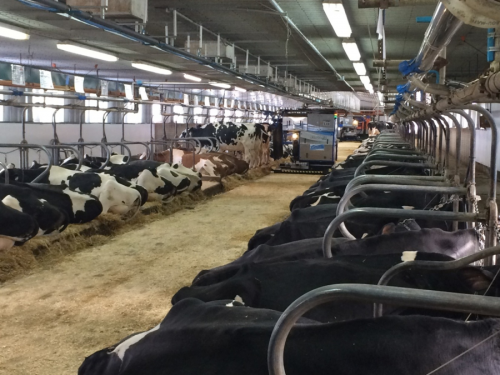Tie-stall barns have many advantages when it comes to cow comfort. This type of herd management makes possible a pro-active, individualized approach to each animal and its welfare. It results in faster response time to an animal’s needs and less reliance on medical treatments such as antibiotics.
- Individualized follow-up: A dairy farmer can determine much sooner when a specific cow’s eating and behavior changes, indicating health problems or discomfort. This results in a quick response to the animal’s needs.
- Rapid assessment of excrement: Visual assessment of each cow’s excrement makes possible rapid and precise evaluation of an animal’s overall health. This results in a quick response to the animal’s needs.
- Feeding improvements: Each cow has easy access to water and food without obstruction from competing animals, a key element of cow welfare.
- No competition: Injuries caused by the competitive behavior of dominant cows are eliminated.
- Hoof health: Individual maintenance of each cow’s stall helps reduce to a minimum health problems such as foot rot without using chemicals (foot bath).
- Superior sanitary conditions: Each animal is provided with a comfortable stall where drier bedding provides superior sanitary conditions. Reductions in barn humidity also greatly reduce cross-contamination risks between animals.
Milkomax’ Tie-Stall AMS brings to an even higher level of excellence individual cow monitoring and care. It allows a dairy farmer to receive information at all time regarding the condition and welfare of each animal. This frees time that farmers can use to further improve their herd’s health and welfare.
Milkomax recommends that all Canadian dairy farmers, whether their barn is free-stall or tie-stall, follow the guidelines found in the Code of Practice for the Care and Handling of Dairy Cattle.
Helpful links regarding animal comfort in tie-stall barns:
Fonds de recherche Nature et Technologies (English version) (Quebec Government): ‘’And yet, tethered animals can be extremely comfortable – and equally, if not more, productive – if some simple guidelines are respected.’’
The Canadian Code of Practice for the Care and Handling of Dairy Cattle contains specific guidelines to ensure that a high level of cow comfort is achieved in tie-stall barns.
The Practical Guide to Evaluating and Improving Comfort in the Barn is designed to promote the constant improvement of animal comfort in all types of barns. Interestingly, this document illustrates that even in a free stall environment, a cow naturally spends most of its time in a stall or standing still (see the chart A Cow’s Regular Daily Routine).
”With the right design, tie stalls can provide excellent cow comfort. […] Well-designed tie stalls optimize airflow, keep feed and water within cows’ reach and enable efficient manure removal. When the right pieces come together, production and cow comfort can flourish.” – Cow comfort matters in tie stalls, too, Hoard’s Dairyman February 17, 2015.


A Cow's Regular Daily Routine
- Milking
- Eating
- In the alleys and drinking
- Standing up in the stall
- Lying
- Milking
- Eating
- In the alleys and drinking
- Standing up in the stall
- Lying
Source: Gomez, A.; Cook, N. B. (2010) Time budgets of lactating dairy cattle in commercial freestall herds. Journal of Dairy Science. 93(12):5772-5781.

